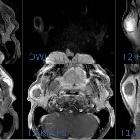Adenoid-zystisches Karzinom der Speicheldrüsen



Adenoid cystic carcinoma of the salivary glands is the second most common malignancy involving the minor salivary glands behind mucoepidermoid carcinoma and the second most common malignancy involving the parotid gland.
Pathology
Adenoid cystic carcinomas arise more commonly in the minor salivary glands (~55%) than in the major salivary glands. They are the most common sinonasal tumors of salivary origin. They are locally aggressive with a propensity for perineural spread .
Radiographic features
Generally, a distinction is made radiologically between low-grade and high-grade adenoid cystic carcinomas. Low-grade tumors tend to be well-defined, in contradistinction to high-grade tumors, which appear infiltrative. However, both subtypes are usually homogeneously enhancing after contrast administration.
Adenoid cystic carcinomas are frequently associated with perineural spread (via cranial nerve VII), which is well appreciated on MRI.
MRI
Signal characteristics
- T1: hypo- to isointense
- T2: slightly hyperintense, with higher grades being markedly hyperintense
- T1 C+ (Gd): homogeneous enhancement
See also
Siehe auch:
- Hirnnerven
- Parotistumoren
- Tumoren der Speicheldrüsen
- Adenoid-zystisches Karzinom
- adenoid cystic carcinoma of the lacrimal gland
- adenoid cystic carcinomas
und weiter:

 Assoziationen und Differentialdiagnosen zu Adenoid-zystisches Karzinom der Speicheldrüsen:
Assoziationen und Differentialdiagnosen zu Adenoid-zystisches Karzinom der Speicheldrüsen:


